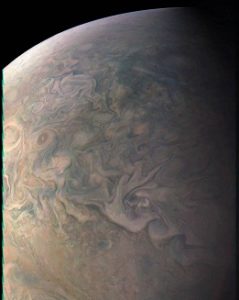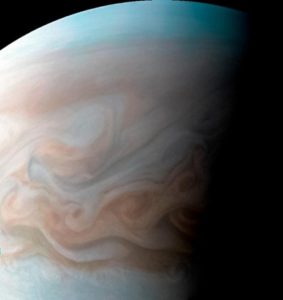
Juno spacecraft has sent a high-resolution, close-up image of Jupiter, showing the turbulent region just west of the Great Red Spot in the South Equatorial Belt.
The image was captured with JunoCam citizen science instrument on Dec 11, 2016, when Juno was flying at an altitude of just 8,700 kilometers above Jupiter’s cloudtops. With help from citizen scientists, the images sent by Juno are getting processed and showing the gaseous giant as it has never been seen before. According to NASA, citizen scientist Sergey Dushkin completed the sublime color processing on the latest image and also cropped it to draw viewers’ eyes to the dynamic clouds. The image shows Jupiter’s cloud tops west of the Great Red Spot “with resolution better than any previous pictures from Earth or other spacecraft.”
JunoCam’s raw images are available at www.missionjuno.swri.edu/junocam for the public to process into image products.

Jupiter is the largest planet in our solar system and appears to astronomers as a deep red orb surrounded by layers of orange, pale yellow, and white. Jupiter’s Great Red Spot is actually a massive, spinning storm – more than twice Earth’s size – in the atmosphere of the planet. The maximum speed of winds inside the storm sometimes reaches about 270 miles per hour.
Juno is a NASA space probe launched from Cape Canaveral on August 5, 2011, with an aim to study planet Jupiter. Juno was built by Lockheed Martin as part of NASA’s New Frontiers program to study Jupiter’s composition, magnetic field, gravity field, and polar magnetosphere. It is operated by NASA’s Jet Propulsion Laboratory. Juno entered a polar orbit of Jupiter on July 5, 2016. The mission life of Juno is 20 months, and during this period, Juno will try to find clues about the formation of Jupiter, the amount of water present within the deep atmosphere, mass distribution, its core composition, and its deep winds. After completion of the mission, the spacecraft will be deorbited into Jupiter’s atmosphere.
Juno is the second spacecraft, after Galileo, to orbit Jupiter. The nuclear powered Galileo spacecraft orbited around Jupiter from 1995 to 2003. Juno uses its solar arrays to get power to operate. Juno has three largest solar array wings ever deployed on a planetary probe, which generate power for Juno and also help in stabilize it.
